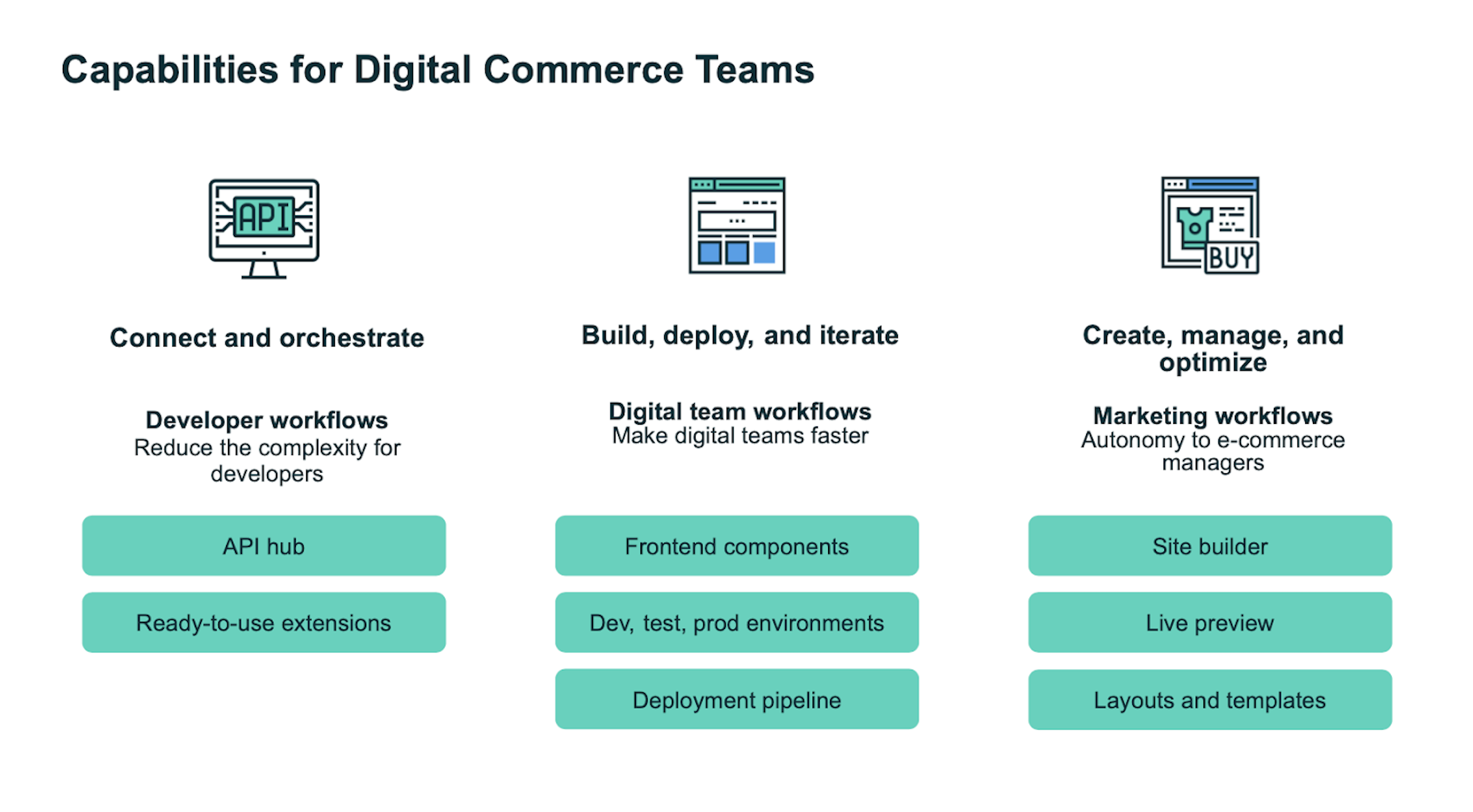
Creating stunning digital storefronts has never been more vital for brands to thrive in a crowded marketplace. And yet, bringing new frontends to market — and adapting them over time — hasn’t been a straightforward process. So, how can you reduce implementation time while crafting differentiated customer experiences? A composable frontend solution, or frontend-as-a-service (FEaaS), provides a compelling alternative.

A digital storefront, technically known as the frontend, enables customers to discover, buy and engage with your brand. You could compare it with the face (hopefully, with a smile) of the business, welcoming everyone who visits the site and guiding them through an engaging experience that leads to a purchase, a loyalty membership and/or a long-term relationship. That's why, designing, implementing and adapting frontends is not only one more item you have to cross off from a checklist; it’s a real opportunity to stand out from the crowd, build meaningful relationships with your customers and unlock revenue streams over time.
So, why is it so difficult still today for brands to create stunning frontends without spending weeks or months to accomplish it? And why does the creation of fast-loading, omnichannel-ready and mobile-first storefronts take such a monumental effort?
Historically, brands relied on legacy, monolithic platforms to create and run web shops with a standardized solution. While this one-size-fits-all approach may seem simpler and faster to implement, the truth is that it severely limits customization and innovation, preventing brands from differentiating experiences or easily adapting to new customer demands.
Scalability is also an issue as the infrastructure is usually on-premise or cloud-hosted (as opposed to “cloud-native,” which takes full advantage of cloud computing capabilities), so scaling up or down online capacity to meet customer demand is typically problematic around Black Friday-like traffic peaks.
To avoid the limitations and constraints of legacy technology, businesses often turn to completely custom-built frontends based on frontend frameworks. By enabling developers to build custom frontends from scratch, it’s possible to create hyper-customized online stores. While crafting a tailor-made eCommerce website or application that aligns perfectly with your requirements is undeniably appealing, it requires significant digital expertise and extensive developer resources. And, by creating frontends from the ground up, you have to consider a lengthier implementation time.
With frameworks being essentially a developer playground, business users (think marketers, content managers, etc.) are essentially ignored from being an integral part of creating, managing and adapting digital storefronts. With the onus of responsibility on developers’ shoulders, they’re stuck with updating/adapting/changing the frontend instead of focusing on innovation and value-adding tasks.
With the rise of composable technologies, you no longer have to resign yourself to custom-built solutions on top of frameworks or create online shops with legacy tech. With an FEaaS solution, you can balance customization needs, implementation time and resources needed to create stunning digital storefronts and adapt them over time.
What’s FEaaS and how will you benefit?
Frontend-as-a-service provides a build-and-buy approach that gives brands the ability and flexibility to develop individualized frontends from scratch without running into time-intensive projects. Built on modern development principles such as MACH® and composable commerce, FEaaS provides the architecture for an optimal frontend delivery and orchestration with the commerce backend, so developers don’t have to worry about infrastructure aspects. At the same time, developers can use pre-built models and ready-made integrations which can serve as a starting point for the development process — or even as an inspiration for a custom storefront entirely.
Together, these elements enable developer teams to construct the entire frontend experience in a fraction of the time (especially in comparison with frameworks) and orchestrate it in one place while achieving custom storefronts. This way, they can focus on building customizations and personalized customer journeys with the FEaaS offering as a foundation.
With the possibility to create and adapt frontends faster and more efficiently, brands can constantly deliver new ways of engaging customers, optimize omnichannel experiences and keep up with the ever-evolving demands of shoppers. Benefits also include:
Out-of-the-box and SEO-friendly frontend capabilities for superb UX, and fast-loading and highly performant storefronts no matter the shopper's device (desktop, mobile) with progressive web apps (PWAs).
Fast time-to-market down from months to weeks.
Maximized flexibility: Developers have the freedom to fully customize frontends but also can use prebuilt frontend components where it makes sense.
Based on established industry standards.
Less resource-consuming thanks to standard components and functionalities.
Better ratio between maintenance efforts and innovative customer experience.
Ready-made integrations with other API-driven solutions.
Includes infrastructure, hosting and support, translating into significant time and cost savings.
With a composable, best-of-breed approach, you can change vendors of your frontend tech stack whenever your business needs change.
Just like any technology replatforming project, there are costs involved when implementing an FEaaS solution, which may be associated with licensing, partner fees or security. However, this is the investment to future-proof your digital commerce. For instance, instead of spending months to launch a digital storefront, you’re equipped with the tools to accelerate your time-to-market, which translates into a faster time-to-value and quicker ROI.
4 common misconceptions when exploring a composable frontend solution
Frontend-as-a-service is a relatively new market category, so understandably, many business executives and technology leaders hold a few misconceptions about the solution. Let’s debunk the top four:
Misconception #1 — Limited freedom and control over the frontend development
Some believe that using FEaaS means sacrificing control and freedom over the frontend of their website. However, these solutions actually offer a high degree of customization and flexibility, allowing businesses to tailor the frontend to their specific needs and branding requirements. In short, developers can build and customize frontends as they see fit, as FEaaS is essentially a composable solution.
Misconception #2 — Generic look and feel
It is often assumed that FEaaS solutions result in websites that all look similar and lack uniqueness because many executives confuse it with services like Drupal or Shopify. In contrast, businesses can achieve a distinct and personalized look and feel with the right customization options.
Misconception #3 — Vendor lock-in
Some executives worry that relying on an external service provider for their frontend will lock them in with a specific vendor. The very nature of a composable frontend is that brands can change their tech stack with much more ease than with a legacy platform.
Misconception #4 — High TCO
While the upfront investment may be higher when replatforming to a composable platform, brands greatly reduce TCO as development, hosting and integration costs decrease over time.
Starting with FEaaS: Why use commercetools Frontend
commercetools Frontend provides a complete tooling package for business users and developers to create, optimize and customize their digital storefronts. Delivered as PWAs and connected by the API hub for orchestration with the eCommerce engine and all other APIs, commercetools Frontend delivers fast-loading and responsive experiences to boost your digital presence, SEO rankings and conversion rates.
As a leading composable frontend solution, commercetools Frontend encompasses every aspect of the development process and manages the entire lifecycle of your digital storefronts with the following elements:
Developer tooling
The tools and workflows your tech team needs to develop, deploy and deliver sites. Create the design and user experience easily with UI frontend components in Next.js or choose from a comprehensive component library.
No-code business tooling (Frontend Studio)
Unlike other frontend solutions, commercetools Frontend comes with business tooling that empowers your digital teams to manage and optimize the storefront experience.

API hub
Execute your best-of-breed strategy with seamless sync between your commerce backend and frontends. With the API orchestration layer, all the pieces of your tech stack come together and can deliver a seamless experience. This layer unifies the multiple backend APIs, making data, processes and actions available for any channel through just one API. Aligned with commercetools Composable Commerce workflows, you can streamline omnichannel API orchestration and the web frontend (desktop and mobile) composition and delivery process.
Delivery
Deliver fast, reliable and secure shopping experiences — no matter your order volume or traffic spikes. commercetools Frontend is powered by Google Cloud and Netlify and delivered as PWAs with auto-scaled cloud hosting, offering 99.9% SLA and 24/7 service. Combined, these elements ensure a fast, accessible and performant experience on any device.
Pre-installed and launch-ready storefront: The Good Store
Frontend developers can streamline the development process and quickly launch stores and take advantage of UX/UI best practices out-of-the-box with The Good Store by commercetools Frontend.
With commercetools Frontend, your brand can create stunning and highly performant digital storefronts faster. Equipped with comprehensive frontend tooling for digital teams and developers, you can build, customize and adapt digital storefronts with remarkable speed, just like renowned brands CHRONEXT, APG & Co., Apollo Optik and Flaconi have successfully achieved.
Are you ready to build amazing commerce sites with commercetools Frontend? Download The Business Leader Guide to Digital Storefront Technology to learn more.